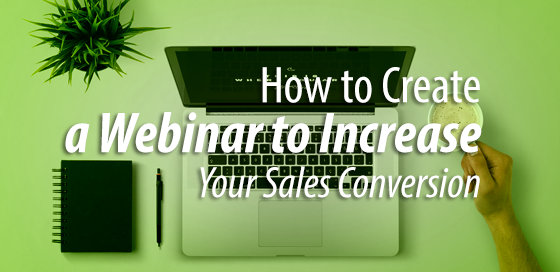As white papers and ebooks are to blogs and articles, webinars are to videos: a longer, more in-depth form of content, geared towards those in the middle of the sales funnel. Getting people to register for your free webinar can be a great method of lead generation. But even more than that, it can be an excellent tool for sales conversion. Here’s a step by step guide to creating a webinar with a high conversion rate.
Step 1: Engage the Audience
Webinars aren’t about overtly selling your product or hitting the audience over the head with why your company is the best choice for their needs. It’s about keeping them informed and helping them solve a problem. Unlike white papers and ebooks, however, webinars provide you with a unique opportunity to engage your audience directly, and steer the content towards their concerns.
Ask a few questions, to get a feel for what your audience’s background is, why they’re here, and what they’re hoping to accomplish. Make sure the webinar player includes a chat box, so that people can voice their responses and comments, and that the host of the webinar can access these responses in real time.
Start with basic questions, like, “How many webinars have you attended in the past?” or “How much experience do you have with our brand?” Questions like this will break the ice and get them in the habit of responding to you, so that you can get a dialogue going. Once that’s established, it will be easier to get them to ask you their questions later on.
Step 2: Keep Them Interested
The interactive aspect makes webinars superior to white papers and ebooks. The drawback, however, is that someone reading a white paper can do it on their own time. Read the first section today, the next tomorrow, etc. A webinar is a preset chunk of time, anywhere from 45 minutes to a couple of hours that everyone must experience together. Which means you need to keep their attention for that entire time. If you can’t, then attendees are likely to leave before it’s finished—and unlike written content, they can’t simply come back to the same spot later.
Maintaining interest begins with the topic. Remember, a webinar is about solving a specific problem, so phrase it as such: “How to ____” or “5 Steps to ____.” This is much more likely to bring people in than a simple statement of the topic you’re covering.
Next, have a slide listing all the things that your audience can expect to learn over the course of the webinar, to give them a roadmap. Have them listed on the landing page as well, so that your audience can follow along more easily. Even if you start to lose someone’s attention, they know that the next topic is something that interests them, and they’ll stick it out to hear what you have to say.
Step 3: Provide Value
A webinar is first and foremost about education. As mentioned, you’re helping your audience solve a problem, and sharing some knowledge that will benefit them. Therefore, your content needs to provide specific solutions that speak to this.
Sometimes, the temptation in a free webinar is to give vague, general advice, while promising that if your audience buys your product, they’ll get a more detailed solution. This will just make them feel cheated and frustrated, and less likely to buy from you, rather than more. Instead, lay out the steps towards a solution in clear detail. One of those steps or solutions can be your product, but it shouldn’t be the only one. Provide practical advice for what they can do. Make them feel that they’ve gotten real value from the time they’ve spent with you. Then…
Step 4: Make the Pitch
Now that you’ve got your audience hooked, it’s time to reel them in. Make the transition from advice to sales pitch smoothly. Don’t hit them over the head with it. Particularly if you’ve already mentioned your product as one solution to the audience’s problem, then now is an ideal time to talk about it in more detail. Make sure you talk about it in context, highlighting how your product will help them with what you’ve already talked about.
It also helps to offer an exclusive discount to webinar attendees. They’re already hooked, they can see that your product is what they need, and knowing they can get it at a lower cost can be the factor that pushes them over the edge and gets them to buy.
Even though a webinar is traditionally middle-of-the-funnel content, it can still be used to close sales. But remember, you won’t close everyone, and shouldn’t expect to. That doesn’t mean you should write them off. It just means they need a little bit more of a nudge (you are still only in the middle of the funnel, after all). Follow up with your attendees between 24 and 48 hours after the webinar, to see what they thought, and if they have any questions. Continue to nurture them as leads and provide more high quality content that’s geared towards their interests. Maybe they’ll buy after the next webinar.
